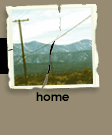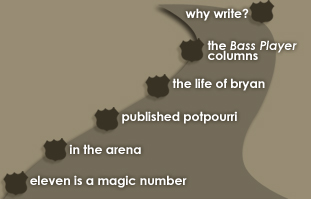
 |
|||||||||
|
|
|||||||||
| Sign up for BellerBytes, the official (and private) Bryan Beller e-newsletter. Just click here to sign up. Do it, OK? | |||||||||
|
CD Review
of Pink Floyd's "Let's
all have a clap.come on, I can't hear you! Put your hands together! In case there was any doubt about the level of contempt Roger Waters had for the typical rock 'n' roll audience by 1980, keep in mind that just before he facetiously exhorted the crowd with the above quote, he sneered into the microphone, "Is there anybody out there who's weak?" When the crowd reflexively cheered, he growled his response with such venom you could practically taste the acid dripping from his lips: "Pathetic." Such was the point of Pink Floyd's landmark masterpiece The Wall. The alienation and complete separation between the band and its audience-S.O.P. for any band as big as Floyd was at the time-was duly noted by Waters, who figured that they could probably throw anybody up there on stage and play Floyd's hits and not only would no one notice, they might not even care if they did. And he was right; the opening number, "In The Flesh?", literally was played by the "surrogate band," who wore masks made to look like each individual member. In many ways, it was more of a punk rock statement than anything going on at the time, because it was a "fuck you" to the audience on a larger scale than anything previously attempted. By then everyone pretty much knew that Roger Waters was a bitter chap. The band was barely on speaking terms, everyone had their own separate trailers (with the doors facing away from each other, mind you), and keyboardist Richard Wright already had one foot out the door. But to get too caught up in Waters' torture chamber of a mindset is to miss the magic that was The Wall's music, probably the most cohesive and mature of any rock concept album in history. Floyd's (mainly Waters') songwriting abilities suddenly seemed to grow exponentially; it's difficult to imagine the band that released Wish You Were Here and many albums like it-long on extended jams and short on melodies, however memorable-could only a couple of years later produce whole songs as beautiful as "Hey You" and "Comfortably Numb" as mere pieces of a greater artistic picture. Any student of the album will revel in the extended live performances of "Another Brick In The Wall Pt. 2" (extended solo section), "Mother" (new intro), "Young Lust" (the end doesn't fade out, exposing the fact that each of the eight ending licks are carefully choreographed between Gilmour and Waters), and "The Show Must Go On" (an extra verse). Then there are the chilling delights of material not on the record, such as the urgent "What Shall We Do Now?" (an outgrowth of "Empty Spaces") and, best of all, "The Last Few Bricks," a reprise of the musical themes stated in the show's first half. (True Floyd aficionados will notice a progression voiced mainly in backing vocals that sounds like the middle section of "Dogs" from Animals, but is actually the four-chord backbone of "Don't Leave Me Now.") One can only imagine the complexity of pulling something like this off in 1980, when playing to a click track with taped effects meant wearing headphones the size of cantaloupes. The now-famous theatrical aspect of the show-the wall being built during the first half of the set, the inflatable puppets of the exquisite wife and mother, Gilmour playing the "Numb" solo standing on top of the wall-are all detailed in an excellent double booklet, which features not only interviews with each band member but also with Art Director Gerald Scarfe, Stage Designers Jonathan Park and Mark Fisher, and Front Of House Engineer James Guthrie ("one hundred and six input channels, not including echo returns!" he exclaims at one point). It's essential reading, and a TV special called "Behind The Wall" that recently aired on VH-1 gets into even more detail on how the key players behind the scenes actually staged the show. But the basis for all of it, lest we forget, was the four album sides' worth of music that comprised The Wall, an artistic success of such magnitude that even its infamously dour creator admitted, "It has great musical and narrative shape, good tunes and it's a well-crafted piece of rock 'n' roll theatre. Who knows, I'm only 56, but it may well turn out to be the best thing I ever did." Perhaps, Roger, it may well be. |

|